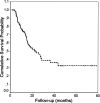Histomorphologic tumor regression and lymph node metastases determine prognosis following neoadjuvant radiochemotherapy for esophageal cancer: implications for response classification
- PMID: 16244542
- PMCID: PMC1409844
- DOI: 10.1097/01.sla.0000186170.38348.7b
Histomorphologic tumor regression and lymph node metastases determine prognosis following neoadjuvant radiochemotherapy for esophageal cancer: implications for response classification
Abstract
Objective: We sought to quantitatively and objectively evaluate histomorphologic tumor regression and establish a relevant prognostic regression classification system for esophageal cancer patients receiving neoadjuvant radiochemotherapy.
Patients and methods: Eighty-five consecutive patients with localized esophageal cancers (cT2-4, Nx, M0) received standardized neoadjuvant radiochemotherapy (cisplatin, 5-fluorouracil, 36 Gy). Seventy-four (87%) patients were resected by transthoracic en bloc esophagectomy and 2-field lymphadenectomy. The entire tumor beds of the resected specimens were evaluated histomorphologically, and regression was categorized into grades I to IV based on the percentage of vital residual tumor cells (VRTCs). A major response was achieved when specimens contained either less than 10% VRTCs (grade III) or a pathologic complete remission (grade IV).
Results: Complete resections (R0) were performed in 66 of 74 (89%) patients with 3-year survival rates of 54% +/- 7.05% for R0-resected cases and 0% for patients with incomplete resections or tumor progression during neoadjuvant therapy (P < 0.01). Minor histopathologic response was present in 44 (59.5%) and major histopathologic response in 30 (40.5%) tumors. Significantly different 3-year survival rates (38.8% +/- 8.1% for minor versus 70.7 +/- 10.1% for major response) were observed. Univariate survival analysis identified histomorphologic tumor regression (P < 0.004) and lymph node category (P < 0.01) as significant prognostic factors. Pathologic T category (P < 0.08), histologic type (P = 0.15), or grading (P = 0.33) had no significant impact on survival. Cox regression analysis identified dichotomized regression grades (minor and major histomorphologic regression, P < 0.028) and lymph node status (ypN0 and ypN1, P < 0.036) as significant independent prognostic parameters. A 2-parameter regression classification system that includes histomorphologic regression (major versus minor) and nodal status (ypN0 versus ypN1) was established (P < 0.001).
Conclusions: Histomorphologic tumor regression and lymph node status (ypN) were significant prognostic parameters for patients with complete resections (R0) following neoadjuvant radiochemotherapy for esophageal cancer. A regression classification based on 2 parameters could lead to improved objective evaluation of the effectiveness of treatment protocols, accuracy of staging and restaging modalities, and molecular response prediction.
Figures





References
-
- Pisani P, Parkin DM, Ferlay J. Estimates of the worldwide mortality from eighteen major cancers in 1985: implications for prevention and projections of future burden. Int J Cancer. 1993;55:891–903. - PubMed
-
- Refaely Y, Krasna MJ. Multimodality therapy for esophageal cancer. Surg Clin North Am. 2002;82:729–746. - PubMed
-
- Kelsen DP. Multimodality therapy of esophageal cancer: an update. Cancer J. 2000;6(suppl 2):177–181. - PubMed
Publication types
MeSH terms
LinkOut - more resources
Full Text Sources
Medical
Research Materials

